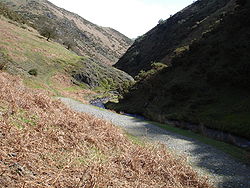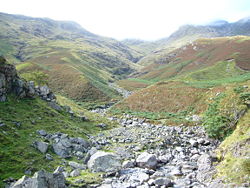
Interlocking spur
Encyclopedia


River
A river is a natural watercourse, usually freshwater, flowing towards an ocean, a lake, a sea, or another river. In a few cases, a river simply flows into the ground or dries up completely before reaching another body of water. Small rivers may also be called by several other names, including...
in which downward erosion
Erosion
Erosion is when materials are removed from the surface and changed into something else. It only works by hydraulic actions and transport of solids in the natural environment, and leads to the deposition of these materials elsewhere...
is the dominant force determining the river's course. As a river wanders between banks that are far apart, the promontories of the hills tend to jut out into the river valley resulting in a staggered formation, interlocked together somewhat like the teeth of a zip. These promontories are referred to as interlocking spurs.
If the river valley is subsequently subject to glaciation, the glacier shears off the tips of the interlocking spurs, due to its straighter course, creating truncated spurs
Truncated spurs
A truncated spur is a geologic formation created under specific conditions which result in a ridge of land with its end cut off. It occurs when ridge spurs, which were formed in a mountainous area by river action, have been truncated by the action of ice or active faulting.-Glaciation:Before...
.
While similar in general appearance, the mechanism behind the formation of interlocking spurs is different to that behind meander
Meander
A meander in general is a bend in a sinuous watercourse. A meander is formed when the moving water in a stream erodes the outer banks and widens its valley. A stream of any volume may assume a meandering course, alternately eroding sediments from the outside of a bend and depositing them on the...
s, which arise out of a combination of horizontal erosion and deposition.

